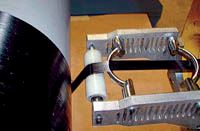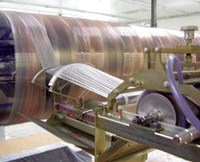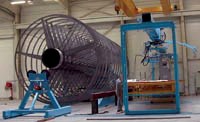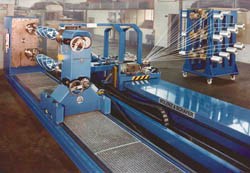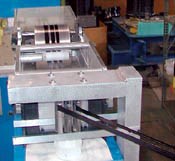A Filament Winder Buyer's Guide
Specifying that new machine with your process and product in mind.
Filament winding is an automated composites manufacturing process in which a mobile placement device wraps continuous fiber reinforcements (resin-impregnated or dry) around the outer surface of a rotating mandrel (male tool) in a controlled pattern to form hollow structures. It can form cylindrical, tapered and spherical shapes; tubes with rectangular or multi-faceted (pentagonal, hexagonal, etc.) and even irregular cross-sections. Part diameter can be as small as a golf shaft, as large as a 38m/125 ft holding tank or as long as an oilfield down-hole drilling pipe.
Filament winding can be done with thermoset or thermoplastic resins and most continuous fiber forms. Fiber may be pre-impregnated (towpreg), pulled through a resin bath before being applied to the mandrel (wet winding) or wound dry and then infused with resin in a secondary process. While towpreg is more expensive than resin and dry fiber, it can be cost-effective for carbon fiber-reinforced parts because it can be wound at higher speeds without throwing resin off the mandrel. Moreover, the resin content of a towpreg part can be more tightly controlled than for a wet-wound part, and for some parts with complex geometries, wet fibers will not stay in place as readily as towpreg. Wet winding, however, is an easier process to master and permits cost-effective winding of hybrid laminates (e.g., combinations of glass and aramid fibers).
Given this varied capability, the process serves a very wide range of markets. High-end winders produce tight-tolerance parts with superior mechanical properties (e.g, rocket fairings and nose cones, helicopter blades, cryogenic tanks and satellite structures). At the other end of the market, volume products, such as light poles, water and sewer pipe, pressure vessels and bike frame tubing, are turned out at relatively high speeds at costs competitive with steel or aluminum.
SYSTEM ANATOMY
In its most common form, wet winding, the process requires five main subcomponents: a creel, a resin bath, a fiber delivery system, a winder and a control system. (Towpreg and dry fiber winding do not require the bath.) A number of individual rovings/tows are pulled from the creel through the resin bath and then through a delivery head, which is mounted on a carriage that can be moved back and forth along the length of the mandrel. The tows are secured to a spiked band called a pin ring on one end of the mandrel, which is supported by spindles on the winder. The mandrel is then rotated, pulling the fiber through the system in a continuous process. The delivery head moves down the mandrel length, placing the tow on the mandrel according to a user-determined pattern. When the head reaches the mandrel's end, another pin ring secures the fibers and the head is moved back along the mandrel to complete one "circuit." The number of circuits determines part wall thickness. The speed of the mandrel rotation with respect to the carriage movement determines the fiber angles and winding pattern. The control system can vary fiber angle from near-axial (as acute as 6°) to radial (90°) orientation, depending on mandrel diameter and the amount of fiber band overlap, to accommodate changes in mandrel shape down the length of the part. The part is then cured and the mandrel typically is removed with extraction equipment.
SYSTEM SELECTION
While the process is broadly capable, an individual winding machine can perform well only in a segment of the range. Depending on the part shapes and end markets served, one or more subcomponents described below may need to be customized to optimize its performance for a particular product type or product mix, part size and/or anticipated production rate and quantity.
The creel is a structure that stores and positions what may be a large number of fiber packages or spools and may include tensioning mechanisms that provide for orderly fiber payout to the winding system. It may be as simple as a bookshelf (for "centerpull" packages of fiberglass) or it may house cantilevered rods with spring-mounted friction pads on which spools are mounted, with fibers exiting through an arrangement of steel bars or ceramic eyes.
Tension mechanisms prevent excessive unspooling during sudden changes in payout speed, and must do so without breaking the fiber (especially difficult with towpreg or high-modulus dry carbon tow) and without excessive fiber damage. Resulting fuzzballs can find their way onto the part, creating surface irregularities. For most applications, the creel is freestanding, but in towpreg or thermoplastic winding, which require fewer spools and no resin bath, the creel can be mounted on the delivery head.
Creels with electronically controlled tensioners are available from most winding equipment manufacturers and from third party manufacturers, such as Izumi International (Greenville, S.C.) or Texkimp Ltd. (Cheshire, U.K.). For tight-tolerance applications, electronic control of tension and unwind speed may be integrated with the winding machine controls. Wolfgang Braun, managing director for winder manufacturer Waltritsch and Wachter (Bodnegg-Rotheidlen, Germany), suggests that the choice of tensioning drive system is critical. "For heavy, slow-moving, or low dynamic, mandrels, we use standard AC motors," he notes. "For high dynamic processes and high accuracy we use servo drives." The latter, he contends, are capable of accelerations up to 8 m/s2 (26 ft/s2) and tension accuracies of 1 to 2 percent over a 4N to 110N (1 lb to 25 lb) range, thus making them suitable for high-spec military and aerospace applications.
In wet winding, fibers are impregnated with resin in the resin bath. Baths fall into two subcategories, dip tank and drum-type. Baths of both types are equipped with a series of bars, rollers and/or combs that separate the fibers before they enter the bath to permit resin infiltration of the interstitial spaces in the tow. To facilitate faster, more thorough wet out, the bath may be heated to reduce resin viscosity.
As the name implies, a dip tank system wets out fibers using a roller system that immerses them in resin. Drum systems pass fibers over a rotating drum, which is partially submerged in resin. The drum picks up resin and transfers it to the fibers. An adjustable doctor blade mounted just above the resin surface skims off excess resin to a thickness appropriate to the desired resin-to-fiber ratio. Many baths also incorporate a squeegee. Typically a thin, semi-flexible material such as polyethylene, the squeegee mounts over the drum. As the fibers pass beneath, it applies pressure to spread fibers, while pushing resin from its wake onto fibers, to encourage wet out.
Generally, a dip tank is sufficient for glass fibers, which are easily wet out when immersed, while the optimum system for carbon fibers is likely to be a drum-type. The latter offers better resin control for critical applications, but does so at the sacrifice of speed. For carbon tows, which require slower speeds to fully wet out, this is not considered a disadvantage.
While a bath may be refilled by hand, large and/or high-volume parts can be produced more efficiently if the bath incorporates an automated filling feature or dispensing equipment. The latter not only fills the reservoir but automatically mixes resin and catalyst to user-specified proportions. "Resin mix and dispense equipment can be integrated completely into the winding machine," says Joe Jansen, advanced system sales engineer for Magnum Venus Products (MVP, Clearwater, Fla.). For thermosets, he adds, "the part A and B resin barrels can be connected via heated reservoirs and a meter/mix head through insulated lines to the carriage-mounted resin bath." MVP's integrated mix/dispense system can include the company's Material Monitoring software, which is designed to record process data and display, in real time, accurate estimates of part fiber volume and material usage.
Resin-impregnated or dry rovings/tows are fed onto the mandrel by the delivery head, mounted on a moving carriage. The head uses a series of combs, bars, D-shaped rings and/or eyes to group the individual strands together in one or more smooth bands as they are wrapped onto a corresponding number of mandrels. Combs are used to guide rovings or tows (without twisting them) toward the D-rings (of varying diameters), flat or curved spreader bars and grooved rollers that are often used in combination to spread and smooth the band and control bandwidth. The shape and arrangement of these components will vary according to fiber type, the number of rovings, and whether the part is wound using wet resin or prepreg. For example, some machines have different setups for delivering hoop (radial or 90°) and helical (any winding angle other than a hoop) windings. Some manufacturers also offer equipment for unusual winding scenarios: MVP makes a head that can wind resin impregnated tow and spray chopped fiber and liquid resin onto the mandrel simultaneously.
On towpreg delivery heads, fiber spread isn't necessary. The key issues are to minimize friction on the material and ensure that the fiber does not twist until the towpreg meets the mandrel. Friction causes resin to build up on winder components, making them tacky and capable of hanging up the towpreg. To minimize friction, rollers are used in place of spreader bars, and delivery eyes are made of smooth, nonabrasive materials.
For thermoplastic towpreg, the delivery head performs two additional functions. It must supply heat both to the towpreg about to be placed and to the material already on the mandrel surface to ensure a good bond, and it must apply compaction pressure as the material is layed down.
The winder supports the mandrel(s) on rotating spindles and incorporates the carriage system on which the material delivery system moves back and forth down the length of the machine. Basic machines have two axes of movement. The spindle rotates and the carriage moves only along the mandrel's x-axis. But winders can be configured for as many as six axes of movement, adding delivery head motion toward and away from the mandrel, delivery head pitch and yaw, as well as vertical motion and rotation of the delivery eye. According to Mike Skinner, president of Skinner Creative (Draper, Utah), most fabricators will find that winders with two to three axes of motion are sufficient and make for a more robust manufacturing process, while six axis winders are used primarily for research.
Winders may be manufactured in gantry or floor-mounted configurations. On gantry machines, the delivery head carriage rides on an overhead rail system. For a heavy part that is not too long, the added structural stiffness of the overhead geometry can be advantageous. Gantries permit easy access to the delivery head and protect the carriage belt or chain from resin drips. Finally, a gantry is more practical for some machine configurations, such as MVP's side-by-side winding system, which uses one carriage to wind materials on mandrels mounted on two side-by-side spindles. When the mandrel on one side is wound, the delivery head can be reversed to wind the other mandrel while the idle spindle is reset.
For parts longer than 4.6m/15 ft, gantry machines can become impractical because the overhead rail system on long spans may sag without intermediate supports. In this case, the more practical option may be a machine with the carriage riding on a beam positioned on the plant floor. Floor mounted machines can be more economical for lighter parts simply because there is less structural steel involved.
Mandrels can be mounted into the rotating headstock using chucks, collars or other clamping mechanisms. Winding operations that require fast turnaround might use pneumatically activated collars, while three-jaw chucks are sufficient for slower processes with heavier mandrels. In either case, the mandrel ends and clamping mechanisms must have compatible designs.
Machines can be single- or multi-spindle, depending on part size and desired productivity. Conventionally, the mandrel is supported by spindles on both ends. However, a cantilever-mounted machine has a spindle on only one end of the mandrel and uses a set of rollers to support the other end. This saves setup time by allowing part extraction without removing the mandrel from the machine. MVP produces machines of this type, for winding parts on large, collapsible mandrels.
The control system includes the motor, motor drive and one or more of several types of control software. In sophisticated systems, motion control software positions the machine axes as specified by the operator. Pattern-generating software is used to define part geometry, winding angles, bandwidth and pattern repeats. This information is translated into machine code (G-codes) that instructs the motion control package as to fiber placement angle and pattern, the number of circuits and the layup sequence. For less complex winding scenarios, however, motion control and pattern software may be unnecessary. A number of manufacturers prefer, instead, to use less expensive, proprietary software and program- mable logic controls, such as those supplied by Rockwell Automation/Allen Bradley (Milwaukee, Wis.), Bosch Rexroth (Hoffman Estates, Ill.) or Delta Tau (Chatsworth, Calif.).
Bolenz and Schaefer/EHA Spezial-maschinenbau GmbH (Steffenberg, Germany) and CNC Technics Pvt. Ltd. (Hyderabad, India) are among the machine suppliers that now use the Siemens (Erlangen, Germany) Sinumerik 840D motion control package, a standardized item available worldwide on short notice. However, it is expensive and not specifically designed for filament winding (e.g., without modification, it cannot run backwards to unwind a poorly positioned tow) and therefore requires adaptive software. The latter is typically incorporated into pattern software, which may pose a problem for those who do not need pattern software.
Pattern software is a must for winders with four or more axes of control or for parts with complex geometries. Choices include Cadwind by Material SA (Brussels, Belgium), FiberGraphix by Entec Composite Machines (Salt Lake City, Utah) and Cadfil by Crescent Consultants Ltd. (Kegworth, Derby, U.K.). The programs cost between $10,000 and $20,000 and have their individual strengths. Cadfil models the machine as well as the wound part, thus avoiding collisions between the delivery eye and the mandrel. Cadwind, (also available in a lower priced program called Cadwind Lite) features a consistent operator input and interface for all the different winding shapes and patterns. FiberGraphix optimizes each interface for a given shape, making it harder to learn but a better performer for certain shapes. Skinner Creative offers free programs on its Web site, including Winding Wizard, which calculates winding parameters such as coverage, bandwidth, pattern repeat and wall thickness, and a new pattern generating program for 2- to 4-axis machines, which generates patterns for pipes and pressure vessels. McClean Anderson (Schofield, Wis.) supplies winding design software compatible with each of its machines.
SUMMING THE PARTS
Evaluating filament winders and determining the subcomponent choices in each of the preceding categories can be a formidable undertaking. Though beyond the scope of this article, auxiliary equipment — curing ovens, mandrel prep fixtures and extractors, part trimming machinery and testing equipment — must be considered as well. Each may be selected or designed to support the particular winding process. Furthermore, an aspiring filament winder may not be sure the process is the best route to its particular product. (For instance, while golf shafts may be wound, they also may be table-rolled from prepreg by hand or using comparatively inexpensive semi-automated rolling machinery.) Finally, the fabricator may be sure that a part should be filament wound but unsure about how part design or process parameters may influence machine design.
Winder manufacturers offer a variety of services to help customers negotiate learning curves and successfully implement processes. Most large, established suppliers will customize equipment for specific applications, once a buyer has committed to a vendor relationship. Many supply appropriate auxiliary equipment as well. Autonational BV (Sneek, Holland), a specialist in turnkey, fully automated composite pipe winding lines, from mandrel prep to post-wind testing, also makes custom winders for pipe elbows and fittings and chopped glass-tanks. Accudyne Systems Inc. (Newark, Del.) supplies a retrofit package that converts an existing winder from thermoset to thermoplastic winding. Entec, a subsidiary of commercial-grade carbon fiber supplier Zoltek Corp. (St. Louis, Mo.), now offers retrofits that enable fabricators to convert conventional machines designed for aerospace grade (3K to 12K) fiber for use with the commercial-grade product. McClean Anderson offers prototyping services and assistance in part program development, using its proprietary control and pattern generating software. MVP maintains a technical center in Seattle, Wash. that is set up to run trials for customers. "Customers can go through the entire process of making their part to make sure the system meets their needs," says MVP's Jansen. "We also build mandrels and design chucks or collars to attach the mandrels to the machine." John Green, president of The Green Sales Guy Inc. (Sandy, Utah) and a rep for Bolenz and Schaefer, points to a complete turnkey factory built in 18 months, concept to startup, for Regasco AS in Norway. The plant is designed to produce as many as 300,000 propane tanks for barbeque grills per year on a single highly automated winding machine.
That said, emerging suppliers in regions where manufacturing costs are lower than those in North America and Europe now design and sell equipment at sometimes substantial discounts. For example, Mikrosam (Prilep, Macedonia) formerly a Bolenz and Schaefer/EHA distributor, has been making winders for six years. Marketing manager Dimitar Bogdanoski says that Macedonia's excess manufacturing capacity and low labor costs keep prices low on 2- to 6-axis machines for wet and towpreg winding. Similarly, CNC Technics saw an opportunity four years ago in the Indian pipe and CNG bottle industries because most Indian winding machines were designed for aerospace applications and were, therefore, unnecessarily expensive.
"Small company," however, does not imply small machines or limited capabilities. Mikrosam makes a two-spindle gantry system that can wind water filter housings as large as 12.5m long by 600 mm (41 ft by 23.6 inches) in diameter. The company can provide servo-controlled resin baths, water- or oil-based heating systems (for thermoset and PEEK resin systems) and a patented "remote maintenance" option that logs vibration profiles for key components, which then can be compared to baseline data to determine the extent of part wear. CNC Technics has begun to penetrate the European market, says managing director B. Vijay Krishna, in part, by incorporating Siemens motors into its winders, supplying ovens and other accessories and promising to stock spare parts for 15 years.
HIRING AN OUTSIDE EXPERT
Given the complexity of the buyer's task, one option is to hire a consultant who has experience with the process. Unaffected by the financial pressures experienced by the buyer, a consultant can provide the objectivity necessary to give issues of machine cost, functionality and service life appropriate weight in the decision making balance. Skinner notes that the complexity of tensioning and delivery systems makes it especially difficult to determine if a particular component will do what the job demands, but no more or less. An experienced consultant can look at a customer's product mix and recommend the optimal machine or machines. Depending on the mix, he notes, "It could be one machine with multiple spindles or several machines with different configurations." According to Skinner, consultants also can go beyond matching machines to jobs and negotiating prices. Some provide start-to-finish services, including development of business plans, trade studies, assistance in product certifications to U.S. and foreign standards, and even the design and commissioning of entire production plants. "A few percent investment up front for a large project (more than $100,000)," he contends, "can save a lot more downstream."
SMALL NICHE, BIG PROMISE
Although the market for winders is relatively small — it accounts for only 10 percent of the composites processes in the U.S. and $20 million to $25 million in machine sales, annually — the process continues to expand its reach. The greater sophistication in today's machine designs and the service-oriented approaches taken by suppliers and consultants have contributed to its recognition as a viable option in many applications. As composites continue to move into high-performance yet highly cost-competitive markets, filament winding offers unrivaled flexibility in material selection coupled with economical processing.
Related Content
Composites manufacturing for general aviation aircraft
General aviation, certified and experimental, has increasingly embraced composites over the decades, a path further driven by leveraged innovation in materials and processes and the evolving AAM market.
Read MoreCombining multifunctional thermoplastic composites, additive manufacturing for next-gen airframe structures
The DOMMINIO project combines AFP with 3D printed gyroid cores, embedded SHM sensors and smart materials for induction-driven disassembly of parts at end of life.
Read MoreWelding is not bonding
Discussion of the issues in our understanding of thermoplastic composite welded structures and certification of the latest materials and welding technologies for future airframes.
Read MoreManufacturing the MFFD thermoplastic composite fuselage
Demonstrator’s upper, lower shells and assembly prove materials and new processes for lighter, cheaper and more sustainable high-rate future aircraft.
Read MoreRead Next
Plant tour: Daher Shap’in TechCenter and composites production plant, Saint-Aignan-de-Grandlieu, France
Co-located R&D and production advance OOA thermosets, thermoplastics, welding, recycling and digital technologies for faster processing and certification of lighter, more sustainable composites.
Read More“Structured air” TPS safeguards composite structures
Powered by an 85% air/15% pure polyimide aerogel, Blueshift’s novel material system protects structures during transient thermal events from -200°C to beyond 2400°C for rockets, battery boxes and more.
Read MoreDeveloping bonded composite repair for ships, offshore units
Bureau Veritas and industry partners issue guidelines and pave the way for certification via StrengthBond Offshore project.
Read More



